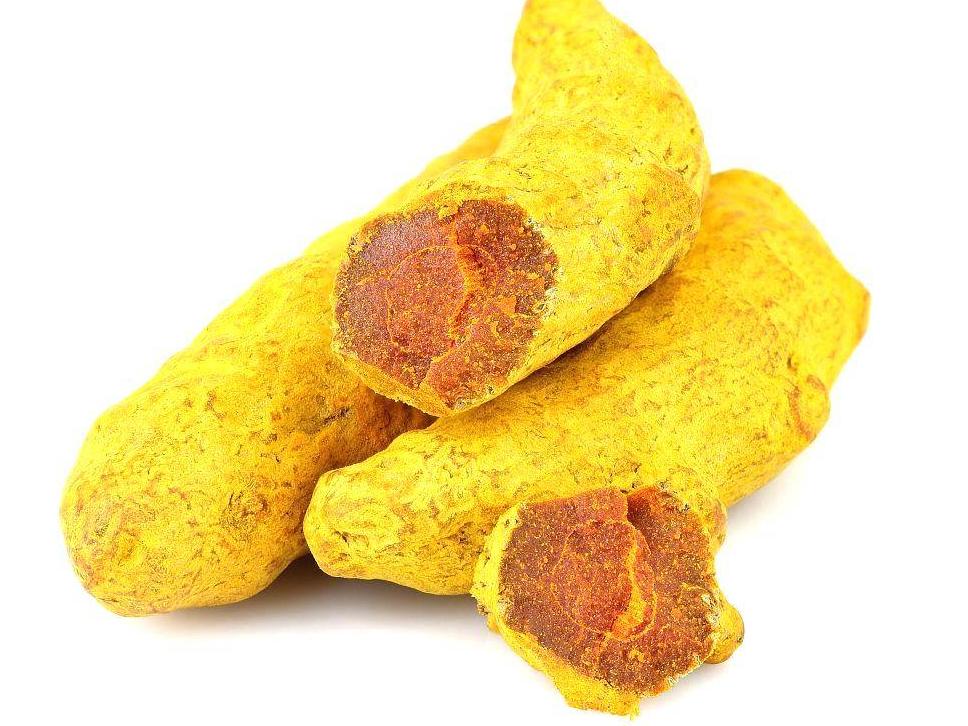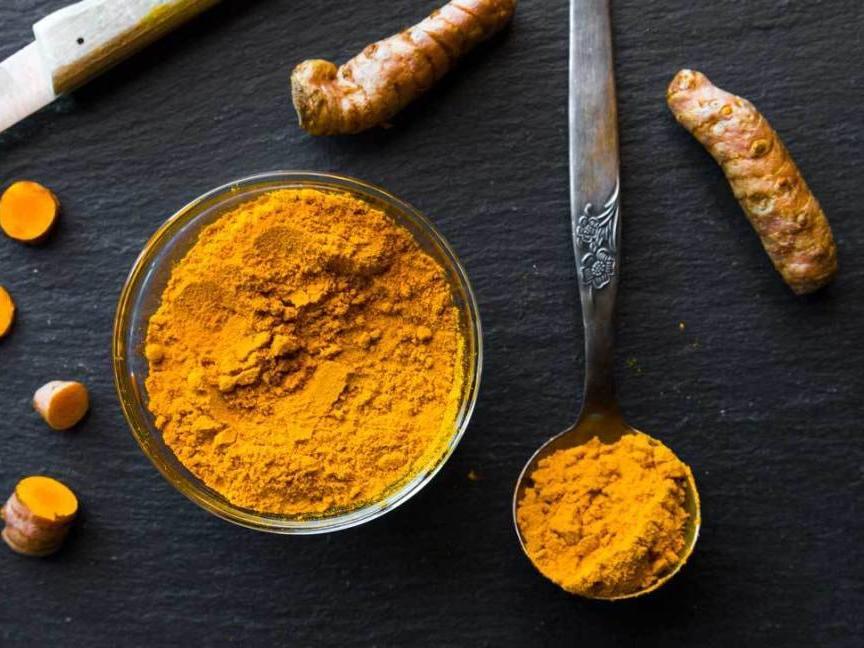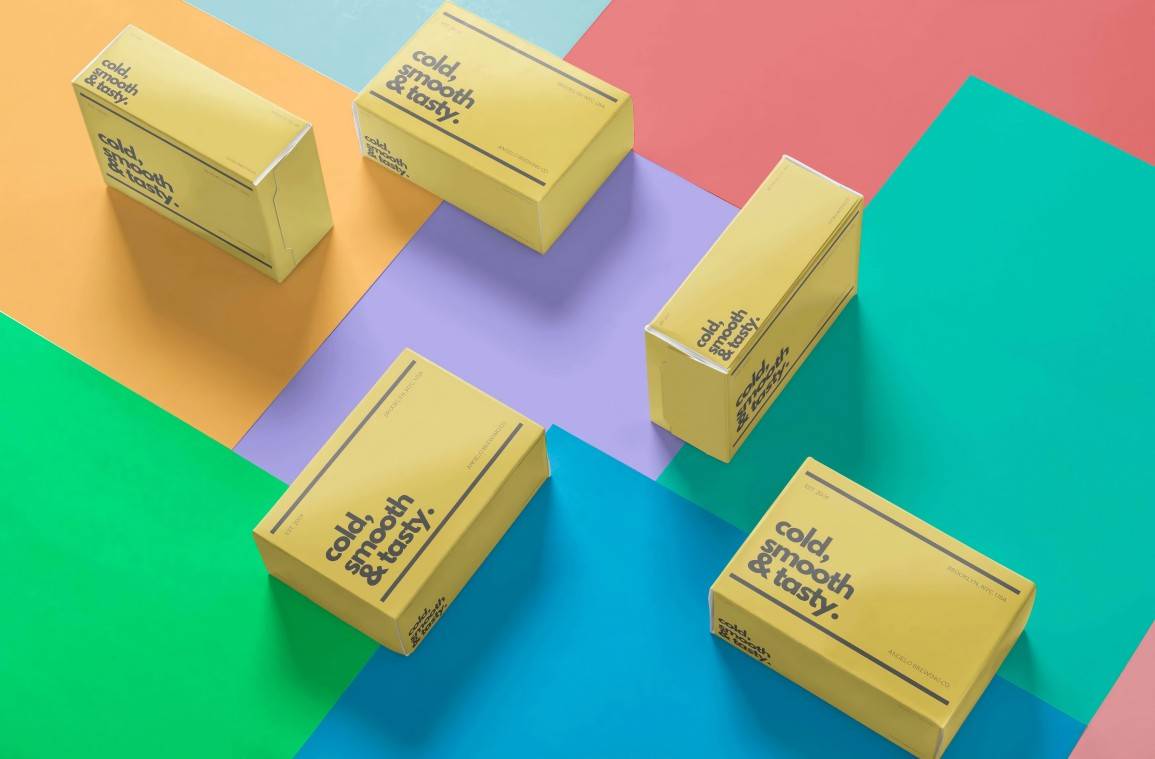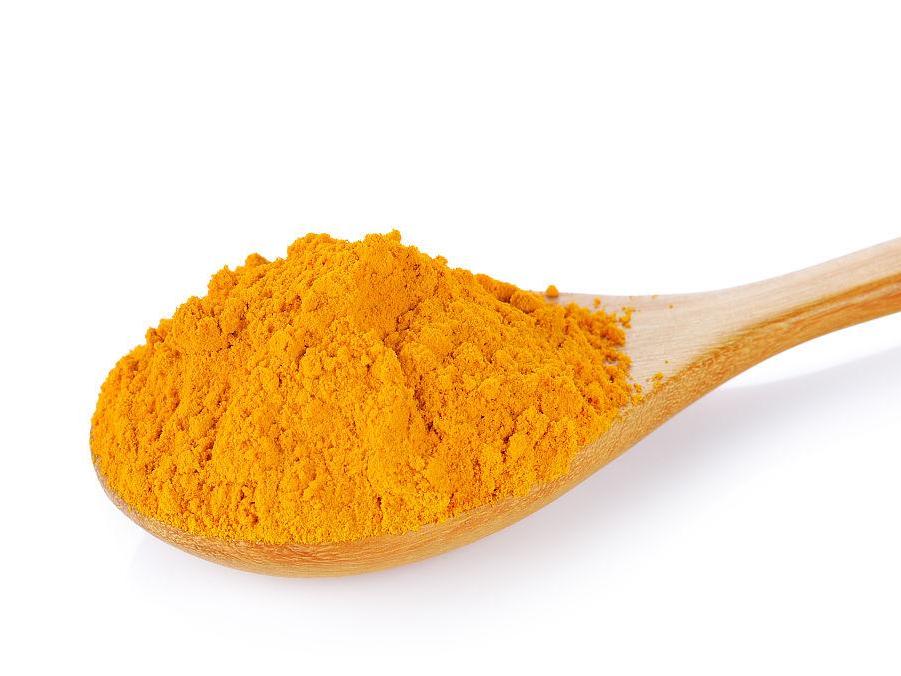What Is the Uses of Turmeric Extract Curcumin Powder in the Food Industry?
1 Introduction
Curcumin is an orange-yellow hydrophobic plant polyphenol compound that is mainly derived from the rhizomes of Curcuma plants in the ginger family (Zingiberaceae) (Figure 1) [1]. It appears as an orange-yellow crystal or crystalline powder with a characteristic turmeric smell, a slightly bitter taste, and is not easily soluble in water. Curcumin is a food flavoring agent, coloring agent, and preservative that is approved by the WHO and other countries. Studies have shown that curcumin has a variety of biological activities, including anti-inflammatory, anti-cancer, anti-oxidant, antibacterial, antitumor, antiviral, hypoglycemic, hypolipidemic, etc. [2-6]. In recent years, curcumin has gradually become a research hotspot. This paper combines domestic and foreign research progress to summarize and analyze the application of curcumin in food from the four aspects of coloring, flavoring, antibacterial and health care, with the aim of providing a reference for the further development and application of curcumin.
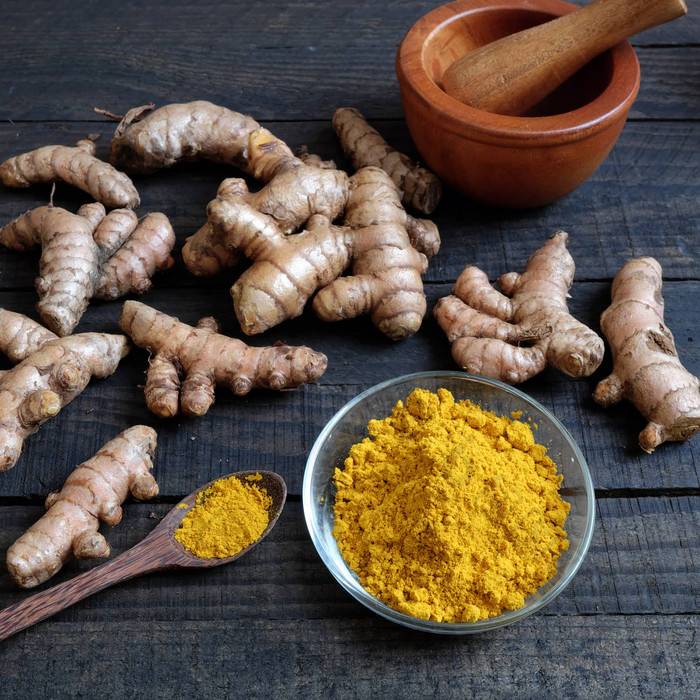
2. Curcumin as a coloring agent in food
In the modern food industry, coloring agents are widely used as food additives. Curcumin, as a natural coloring agent extracted and refined from plants, is safe, reliable, non-toxic and has no side effects. It is one of the seven natural coloring agents widely used in countries around the world [7].
2.1. Curcumin coloring mechanism
Curcumin has the molecular formula C21H20O6 and a chemical structure consisting of two o-methylated phenols and a β-diketone functional group. It is insoluble in acidic and neutral solutions, but soluble in alkaline solutions [9]. Since the hydrogen atom on the β-diketone chain of curcumin can undergo intramolecular transfer, its molecular structure exists in the form of a keto-enol tautomer (Figure 2). The keto form is mainly found in acidic and neutral aqueous solutions, while the enol form is mainly found in alkaline aqueous solutions. The enol form is stabilized by resonance-assisted hydrogen bonding [10, 11].
The solubility and stability of curcumin are related to the type of solvent and pH. Curcumin solutions appear in different colors at different pHs, yellow under acidic and neutral conditions, and red under alkaline conditions (Figure 3). As can be seen from Table 1, at a pH of 7.2, the curcumin solution is still yellow, but begins to precipitate; at a pH of 9.9, the solution is red and has a precipitate. Curcumin is stable to reducing agents, has strong coloring power, and is not prone to fading once colored. It is not only an excellent natural coloring agent in the food industry, but is also widely used in the chemical industry (e.g., cosmetics, hair dyes[12]), pharmaceutical industry (e.g., tablet coatings), and other fields.
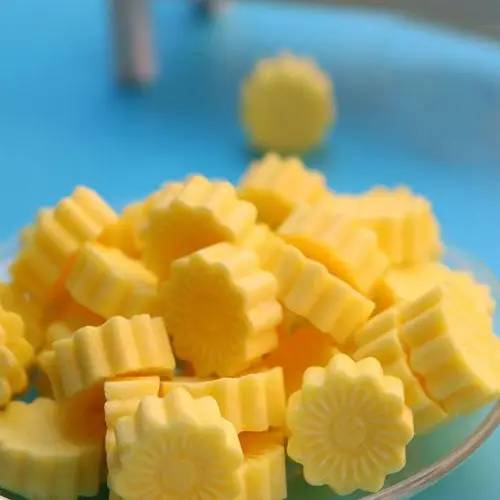
2.2 Coloring function and application of curcumin
Curcumin has a bright color, good colorability and dispersibility, and its dyeing ability is greater than that of other natural pigments and synthetic citrinin, etc. It has a strong dyeing ability on proteins in particular [14]. Curcumin is mainly used for coloring sausage products, canned foods, and braised foods. According to China's GB 2760-2014 Food Safety National Standard Food Additive Use Standard, the maximum allowable amount of curcumin in frozen drinks is 0.15 g/kg, in cocoa products, chocolate and chocolate products, and candy is 0.01 g/kg, in batter, batter, breading and frying powder is 0.3g/kg, instant rice and flour products is 0.5g/kg, flavored syrup is 0.5g/kg, condiments is 0.1g/kg, carbonated drinks is 0.01g/kg, cooked nuts and seeds, grain-based fillings, puffed food is used in appropriate amounts according to production needs [15].
Curcumin is poorly soluble in water, slightly soluble in oil, and can be made into various specifications of products such as alcohol-soluble curcumin, water-soluble curcumin, and oil-soluble curcumin using physical and chemical processes [16], which can be applied to the coloring needs of different foods (Figure 4). In recent years, the use of nanotechnology to construct a delivery system for curcumin (nanoemulsions, liposomes, molecular encapsulation, etc., see Figure 5) has not only solved the problem of curcumin being insoluble in water, but also improved the stability of curcumin and extended the retention time of curcumin coloring [17]. In addition, the combination of water-soluble and oil-soluble curcumin with other natural pigments can turn a product from a single pure yellow color into a natural pigment product with various shades of orange and brown, which is widely used in noodles, instant noodles, beverages, fruit wine, candy, margarine, canned food, fruit juice, tobacco, and cooking dishes. Various food-specific pigments have been developed according to different uses [18, 19]. In summary, the chemical modification of curcumin, nano-encapsulation and compounding with other pigments will become the future development trend in the field of food coloring.
3. Application of curcumin as a condiment in food
Curcumin has a unique taste of turmeric, with a light spicy flavor, a slightly peppery, musky flavor, and a mixture of orange and ginger flavors. It also has a slightly spicy and bitter taste. It has the three elements of “color, aroma, and taste” of food and has good application prospects in the field of condiments [20].
3.1 Application of curcumin as an ingredient in curry powder
Turmeric is an indispensable traditional curry food ingredient in the lives of Indians, and it is also a common condiment for kebabs in the Middle East and Persian and Thai dishes, as well as one of the common colors in mustard sauce [21]. Curry powder is one of the spicy seasonings widely eaten around the world. It is made from several or even dozens of natural edible spices, and it is yellow in color. It tastes spicy and sweet with a unique fragrance [22]. Curry originated in India and was later spread to various countries. Authentic Indian curry is spicy and has a strong aroma. It is mainly made from spices such as cumin, fennel seeds, coriander seeds, mustard seeds, turmeric powder and chili peppers. Turmeric mainly enhances the aroma and coloring, and also has a strong antioxidant effect, which can reduce the level of oxidative free radicals in the body's metabolic process. Curry is widely used in cooking, mostly for cooking meat such as beef, lamb, chicken, duck, crab, etc., but also for cooking vegetables such as potatoes and cauliflower, as well as fruits and soups [23].
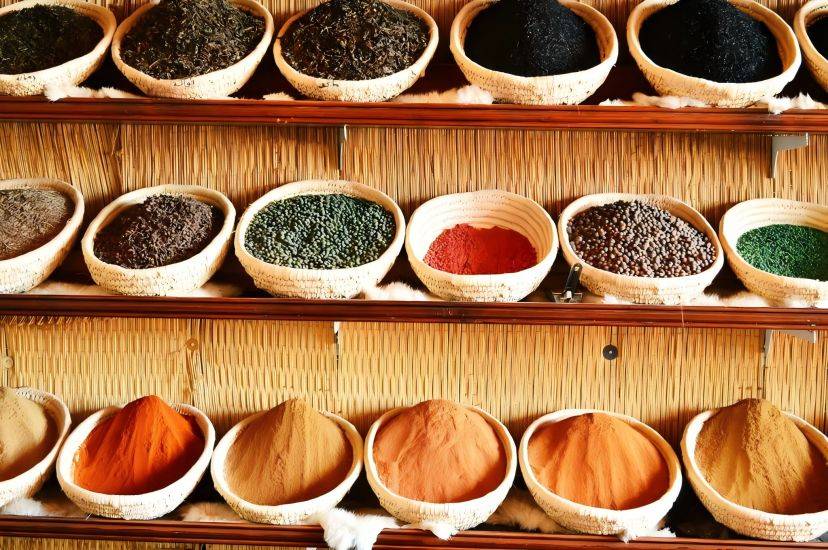
The turmeric content of curry powder produced in different regions varies greatly due to the different origins of the added turmeric raw materials and different eating habits in different regions. For example, the turmeric content of Ideal Curry Powder from Dongguan, Guangdong is 0.33559%; the turmeric content of Wang Shouyi Curry Powder from Zhumadian, Henan is 0.55121%; the turmeric content of Kotanyi Curry Powder from Austria is 0.50968%; the turmeric content of Korea's Budao'er Original Curry Powder is 0.05598%, and the curcumin content of Indian Mido curry powder is 0.16735%. It can be seen that when turmeric is used as an ingredient in curry powder, the different curcumin contents must be considered and their possible impact on the product[24]. Curry not only enhances the flavor and taste of food, but is also good for your health. Curry lovers have a lower risk of developing Alzheimer's disease, possibly because the key ingredient curcumin in curry can break down the accumulation of amyloid protein in the brain, thereby preventing or delaying the onset of Alzheimer's disease. In addition, curcumin, which is abundant in curry powder, has the effect of inhibiting the proliferation of gastric cancer cells.
3.2 Application of curcumin as a natural spice
Turmeric was widely known as Indian saffron in medieval Europe as a substitute for the expensive spice saffron. The two most important active ingredients in the plant turmeric root are curcumin and curcuminoids. Curcuminoids are volatile aromatic molecules that are difficult to retain in turmeric powder. Turmeric powder is a bright yellow spice made by boiling and drying the rhizomes of turmeric and then grinding them [25]. Turmeric oil is obtained by steam distillation of the rhizome of turmeric. Its main components are curcuminoids, aromatic curcuminoids, curcumenes, and zingiberenes. It is an easily volatile, orange-yellow liquid [26]. The United States Federal Emergency Management Agency (FEMA) stipulates that the maximum levels of turmeric oil in beverages, seasonings, soups, meats, and pickled products are 0.78, 59, 30 to 40, 43, and 40 mg/kg, respectively. Turmeric oil can also be used as a tobacco flavoring, with effects such as enhancing flavor, fixing flavor, and preventing mildew. Turmeric oil is obtained by drying and crushing the turmeric rhizome and then extracting it with an organic solvent such as ethanol, propylene glycol or acetone. It is composed of resin, oil and curcumin [27].
The FEMA regulations stipulate that the maximum use levels of turmeric oil in seasonings, meat, pickled products, processed vegetables, and soups are 640, 100, 200, 200, and 1279 mg/kg, respectively. Currently, turmeric is widely used in the food industry as a condiment and pigment. Curcumin can be used to color and flavor foods such as soup, curry powder, cheese, fruit drinks, yogurt, ice cream, and mustard. In actual production, curcumin is widely used in the pasta industry, as well as in baking, puffed foods, meat products, condiments, emulsified flavors, pickled foods, and health products. Turmeric extract can be used as a flavoring agent in chicken seasoning, chili seasoning, puffed seasoning, instant food seasoning, hot pot seasoning, beef jerky and other compound seasonings.
4. Turmeric extract as an antibacterial preservative in food
Curcumin has physiological activities such as antioxidant and antibacterial effects, and has a preservative effect. It can be used as a natural food preservative and is widely used in food processing, food cooking, fruit and vegetable storage and preservation, and dried fruit production.
4.1 The antibacterial and preservative mechanism of curcumin
Curcumin has the effect of antibacterial preservation and scavenging active oxygen, and can be used to prevent bacterial growth and oxidative deterioration in food [28]. The antioxidant mechanism of curcumin is attributed to its unique conjugated structure. The phenolic hydroxyl group and β-diketone group can provide protons during the antioxidant process to block free radical reactions. Curcumin inhibits cell division by binding to tubulin, or disrupts RNA to interrupt protein synthesis, downregulates bacterial gene expression to inhibit bacterial DNA damage response (SOS response), destroys the integrity of bacterial cell membranes and cell walls and other cell structures to inhibit bacterial growth, or inhibits bacterial virulence factors through the quorum sensing (QS) system to inhibit bacterial biofilm formation, as shown in Figure 6 [13]. Studies have shown that curcumin can enhance the antibacterial activity of antibiotics (gentamicin, amikacin, ciprofloxacin, etc.) and exert a synergistic antibacterial effect [29].
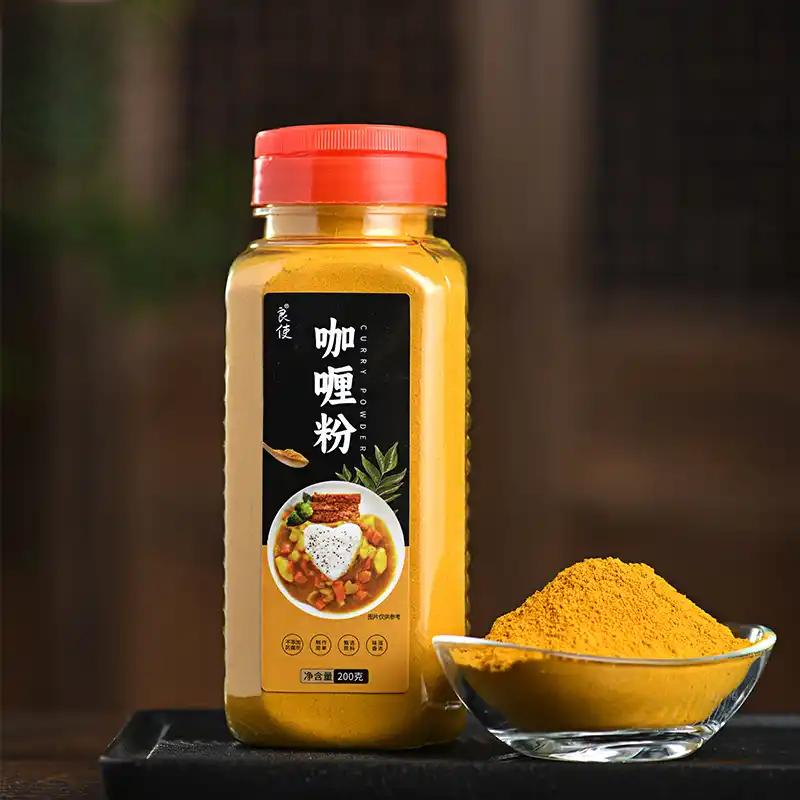
In addition, curcumin absorbs blue light in the absorption spectrum of 400–500 nm and can be used as a natural photosensitizer. Curcumin is activated under blue light irradiation to produce active oxygen, which oxidizes the components of the bacterial cell membrane, causing the bacteria to die [30–31]. Turmeric oil has the strongest antibacterial ability and inhibits Escherichia coli, Bacillus subtilis, Penicillium and yeast [32]. For example, Song et al. [33] studied the antifungal effect of curcumin on Penicillium. They found that 100 μmol/L curcumin combined with 30 min of light could reduce the production rate and survival rate of Penicillium spores. Compared with untreated mold, the treated mold spores showed obvious abnormalities in morphology and ultrastructure, such as atrophy and fragmentation of the cell wall, vacuolation, extrusion of cytoplasm, and blurring of the nuclear membrane and organelles (Figure 7).
4.2 Application of curcumin as an antibacterial preservative
Curcumin can be used as a preservative for meat products, aquatic products and other foods. In one study, turmeric powder and γ-rays were used to treat chicken to improve the meat quality. 3% turmeric powder and 2kGy irradiation at 4°C for 14d effectively eliminated total aerobic bacteria and coliforms [34]. A study also applied turmeric to peeled shrimp (1:1) after refrigeration and found that curcumin can have a bacteriostatic effect and thus extend the shelf life of shrimp [35]. Curcumin has a good preservative effect on fruits, juices, bread, tofu, etc. Soaking navel oranges in 0.05% curcumin preservation solution can effectively reduce the rate of rotten fruit and quality loss, maintain the content of soluble solids, total sugar, total acid and Vc in navel orange fruit, and still have high edible quality after 180 days of storage [36].
Zou et al. [37] found that pineapple slices stored at 4°C and treated with 100 μmol/L curcumin and 10 min of light had better preservation and browning control (Figure 8), indicating that the combination of curcumin and light treatment has a stronger synergistic antibacterial effect on fresh-cut pineapple. A turmeric extract solution with a concentration of 0.025% or higher has a good preservative effect on starchy foods, protein foods and meat foods. It has a certain preservative effect on raw fruit juice only when the concentration is 0.05% or higher. However, curcumin will undergo thermal decomposition after being boiled at a high temperature of 100°C, which weakens its antibacterial effect. Therefore, high temperatures should be avoided during use [38].
Turmeric essential oil has an inhibitory effect on the common spoilage bacteria Aspergillus niger and Penicillium expansum in the production and storage of preserved fruits, which helps to extend the storage time of preserved fruit ingredients before sugar-soaking [39]. Due to the problems of low water solubility, poor stability, and poor compatibility with food matrices, which limit its application, the currently available technological processes for improving the water solubility and stability of curcumin mainly include microencapsulation, electrospinning, and nanoencapsulation, which broaden its application in food preservation [40].
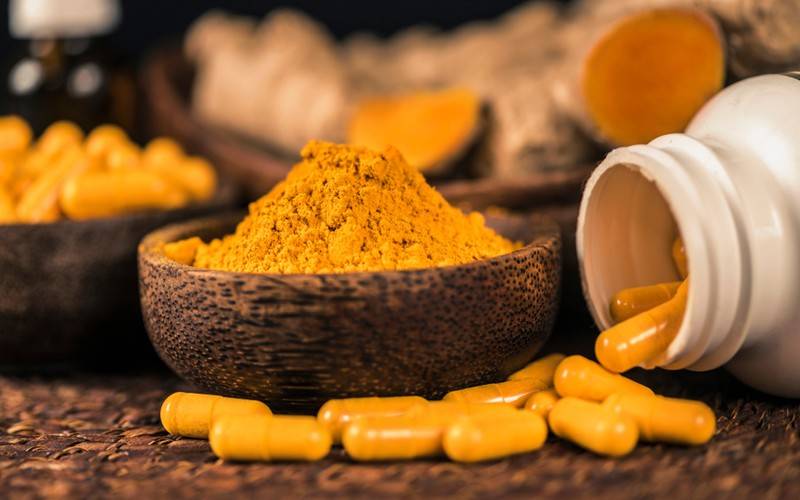
5. Application of curcumin as a functional active ingredient in food for health
As a functional active ingredient of natural origin, curcumin has a variety of beneficial physiological effects on human health, such as anti-oxidation, anti-inflammation, hypoglycemic, hypolipidemic, and immunomodulatory effects. It has great potential for development and application in functional foods and health products. From food to beverages to professional dietary supplements, the application of curcumin is expanding. In 2019, Wahaha launched the hangover remedy and liver protection drink Turmeric Wake Up, New Chapter Turmeric Liver Support from the United States, and Tomen Bi Jian launched the Turmeric Hangover Drink.
5.1 Curcumin as an active ingredient for hangover remedy and liver protection
After alcohol is ingested, it is absorbed through the gastrointestinal tract into the circulatory system, transported to the liver, metabolized and broken down by the action of alcohol dehydrogenase and aldehyde dehydrogenase. Oxidative free radicals are produced during alcohol metabolism, which damages the liver. Curcumin can lower the activity of the liver's glutamic pyruvic transaminase, increase the level of reduced glutathione, and remove oxidative free radicals, thereby protecting and nourishing the liver (Figure 9) [24]. In addition, curcumin has a repairing and protective effect on alcoholic liver damage. Curcumin's liver-protecting effect is due to its powerful antioxidant, anti-inflammatory, and antifibrotic properties [41].
Modern medical research has shown that the occurrence of disease is related to the formation of free radicals [42]. The oxygen consumption inherent in cell growth leads to the production of a series of reactive oxygen species. Reactive oxygen species can damage important biomolecules such as nucleic acids, lipids, proteins and carbohydrates, and may lead to DNA damage, which can lead to mutations. If reactive oxygen species cannot be effectively removed, they will lead to the occurrence of disease, and reactive oxygen species are related to more than 100 diseases [43]. Alcohol is metabolized in liver cells via cytochrome P4502E1 (CYP2E1) and alcohol dehydrogenase (ADH) to form many free radicals, which can alter cell membranes and cause oxidative damage to intracellular substances. Curcumin has strong antioxidant properties and can effectively eliminate and capture free radicals in the body, thereby exhibiting a hepatoprotective effect.
Studies have shown that curcumin can reduce iron-induced liver damage by reducing liver lipid peroxide levels, inhibit low-density lipoprotein (LDL) oxidation in vitro and in vivo, and protect against inflammation induced by carrageenan [44]. Curcumin suppresses liver inflammation mainly by inhibiting inflammatory factors [45] and downregulating the NF-κβ transcription factor [46]. In addition, curcumin can inhibit the increase in serum glutamic oxaloacetic transaminase (AST) and glutamic pyruvic transaminase (ALT), reduce the content of hydroxyproline, and improve liver fibrosis.
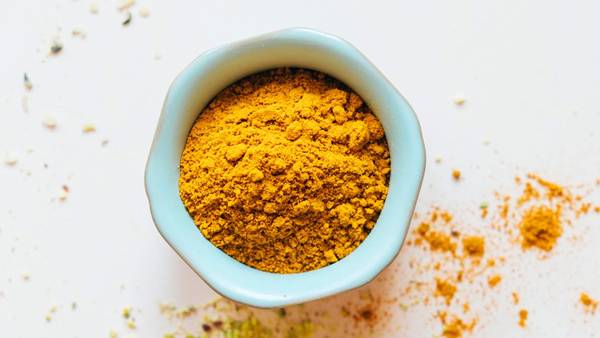
5.2 Curcumin as a lipid-lowering active ingredient
Hyperlipidemia is one of the main factors causing cardiovascular disease (CVD) [47]. Hyperlipidemia, as a lipid metabolic disease, can induce atherosclerosis and is closely related to coronary heart disease, cholelithiasis and other diseases. It is known as one of the “three major killers” of human health [48]. As the hypolipidemic activity of curcumin has gradually been discovered and recognized, pharmaceutical products with curcumin as the main ingredient have appeared one after another.
Curcumin inhibits the expression of the low-density lipoprotein receptor (LDLR) gene by activating the peroxisome proliferator-activated receptor-g (PPARg) and the differential regulation of cholesterol regulatory element binding protein (SREBPs) gene expression, i.e., upregulating SREBP-1 and downregulating SREBP-2, thereby reducing the level of intracellular cholesterol and inhibiting low-density lipoprotein (LDL) [49]. It can also increase the content of apolipoprotein A (APOA) and promote the metabolism of high-density lipoprotein (HDL), thereby accelerating the metabolic breakdown of cholesterol and the rate of inflow and outflow, and reducing intracellular cholesterol.
Curcumin can reduce the effect of lipopolysaccharide (LPS) on rat liver, reduce the content of thiobarbituric acid reactive substances (TBARS), increase the activity of glutathione (GSH) and superoxide dismutase (SOD), thus showing its lipid-lowering and anti-lipid peroxidation effects [50]. Studies have shown that curcumin can regulate lipid accumulation in monocytes/macrophages, reduce lipid levels in adipocytes, and increase FOXO3a transcriptional activity to protect vascular system inflammatory cells from oxidative and lipid-induced damage [51]. In a 2018 study of hemodialysis patients by Nezhad et al., found that the blood lipid levels of patients who took 80 mg of curcumin for two months were reduced, including a decrease in low-density lipoprotein cholesterol (LDL-C) concentration and an increase in high-density lipoprotein cholesterol (HDL-C) concentration [52].
5.3 Curcumin as an immune-modulating active ingredient
The immune system consists of extremely complex central (bone marrow, thymus) and peripheral (lymph nodes, spleen, blood) lymphoid organs and tissues, which are responsible for defending against infection and cancer and for counteracting the harmful effects of organ transplants and autoimmune diseases by secreting various lymphocyte populations and molecules [53]. Numerous studies have found that curcumin can regulate the growth and response of various immune cells in the immune system, including monocytes, neutrophils, natural killer (NK) cells, dendritic cells (DCs), macrophages, and lymphocytes (T cells and B cells), thereby enhancing immune function [54].
Li Xinjian et al. [55] studied the effect of curcumin on the proliferation of mouse splenic lymphocytes and the phagocytic function of mouse peritoneal macrophages by the MTT colorimetric method. The results showed that curcumin can increase the phagocytic function of mouse peritoneal macrophages, and curcumin at 0 to 6.25 μmol/L can significantly upregulate the proliferation of T lymphocytes induced by ConA. The peak effect is observed at 6.25 μmol/L; after 12.5 μmol/L, the effect attenuates and exhibits a stronger inhibitory effect. Curcumin can inhibit the expression of the NF-κB p65 protein in the nuclei of splenic lymphocytes, which may be related to the inhibition of the NF-κB signal transduction pathway.
It can be seen that curcumin has an immunomodulatory effect that is related to the dose. B cells are also important immune cells that develop and mature mainly in the bone marrow. Their main function is to mediate humoral immunity. B cells are also important antigen-presenting cells that can ingest, process, and present antigens. Curcumin can affect the proliferation of B cells and the immune function mediated by B lymphocytes. Curcumin blocks EB virus-induced B cell immortalization by downregulating cyclosporine and hydrogen peroxide-induced oxidative stress [56]. Curcumin also increases the number of B cells in the small intestinal mucosa, which indicates that curcumin has an immunomodulatory effect on the mucosal immune system. In addition, Soe et al. found that curcumin has an immunomodulatory effect on glucose homeostasis and insulin resistance, mainly by increasing plasma insulin levels, thereby activating glycolysis in the liver, inhibiting gluconeogenesis and lipometabolism enzyme activity, and increasing lipoprotein lipase (LPL) activity in skeletal muscle [57].
6 Conclusion and outlook
In recent years, there has been a great deal of research on curcumin. China is one of the world's major suppliers of curcumin and is rich in resources. As a natural coloring agent, flavoring spice and functional active substance, curcumin has a long history of use and is widely used in the food and condiment industries. However, its poor water solubility, instability and low bioavailability have limited its development and utilization, so improving its bioavailability should be one of the main research directions in the future. With the development of the economy and society, people are paying more and more attention to their health, and advocating the concept of natural foods and the integration of food and medicine. As the number of people suffering from chronic diseases such as cardiovascular and cerebrovascular diseases, cancer, diabetes, and chronic respiratory diseases continues to increase, people's demand for functional foods with health-preserving and recovery effects is also increasing. As a food of both medicine and food origin with natural plant sources, curcumin has a variety of biological activities that meet people's health needs and is very popular.
Therefore, in the future, products using curcumin as a coloring agent, preservative and flavoring agent should be repositioned to highlight their physiological effects and increase the added value of these products. Functional foods with curcumin as the main ingredient can be developed. These foods can be in the form of general foods, such as health milk, functional drinks and pastries, or in the form of non-food products, such as capsules, pills or medicines. In short, with the deepening of research on the physiological activity of curcumin and the improvement of its bioavailability, curcumin products will have a broader application prospect.
Reference:
[1]Jurenka J S. Anti-inflammatory properties of curcumin ,a major constituent of Curcuma longa :A review of preclinical and clinical research [J] . Alternative Medicine Review :a Journal of Clinical Therapeutic ,2009 ,14(2):141-153.
[2] Shah D ,Savaliya R ,Patel P ,et al . Curcumin Ag nanoconjugates for improved therapeutic effects in cancer [J]. International Journal of Nanomedicine ,2018 ,13(T-NANO 2014 Abstracts):75-77.
[3]Rai M ,Ingle A P ,Pandit R ,et al. Curcumin and curcumin- loaded nanoparticles :Antipathogenic and antiparasitic activities [J]. Expert Review of Anti-Infective Therapy ,2020, 18(4):367-379.
[4]Pulido-Moran M ,Moreno-Fernandez J ,Ramirez-Tortosa C ,et al . Curcumin and health [J] . Molecules :Basel, Switzerland ,2016 ,21(3):264.
[5]Aggarwal B B ,Sundaram C,Malani N ,et al. Curcumin :the Indian solid gold [J]. Advances in Experimental Medicine and Biology ,2007 ,595 :1-75.
[6] de Almeida M ,da Rocha B A ,Francisco C R L ,et al.Evaluation of the in vivo acute antiinflammatory response of curcumin-loaded nanoparticles [J]. Food & Function ,2018 ,9 (1):440-449.
[7] Xu C, Liu Y, Chen Y, et al. Research progress on the physiological activity, metabolism and bioavailability of curcumin [J]. China Food Additives, 2016 (9): 203-210.
[8] Ren Shuang, Dong Wenxia, Liu Jinfang, et al. Research progress on the encapsulation of curcumin in food delivery systems [J]. Food Science, 2021, 42(9): 264-274.
[9] Sharma R A ,Gescher A J ,Steward W P. Curcumin :The story so far [J]. European Journal of Cancer ,2005,41(13): 1955-1968.
[10] Anand P ,Kunnumakkara A B ,Newman R A ,et al . Bioavailability of curcumin :Problems and promises [J] . Molecular Pharmaceutics ,2007,4(6):807-818.
[11]Parimita S P,Ramshankar Y V ,Suresh S,et al. Redetermination of curcumin :(1E ,4Z ,6E)-5-hydroxy-1 ,7-bis (4-hydroxy-3-methoxyphenyl)hepta-1 ,4 ,6-trien-3- one [J]. Acta Crystallographica Section E,2007,63(2): 0860-0862.
[12] Gao Lihong. Synthesis, hair dyeing and mechanism of curcumin [D]. Wuxi: Jiangnan University, 2013.
[13] Zheng D T ,Huang C X ,Huang H H ,et al. Antibacterial mechanism of curcumin :A review [J] . Chemistry & Biodiversity ,2020 ,17(8):e2000171.
[14] Liang Jinli, Meng Yuzhu, Lei Changgui. Study on the preservative properties of curcumin [J]. China Food Additives, 2007 (2): 73-79.
[15] National Health and Family Planning Commission. Food safety national standard: food additive use standard: GB 2760-2014 [S]. Beijing: China Standards Press, 2015.
[16] Fan Shuqi, Zhang Baojun, Li Chunlin. Natural curcumin and its application in fruit and vegetable drinks [J]. China Food Additives, 2002 (5): 57-59, 78.
[17] Chen Shuai, Sun Cuixia, Dai Lei, et al. Research progress of curcumin delivery carriers based on biological sources and nanotechnology [J]. Chinese Journal of Food Science, 2019, 19 (8): 294-302.
[18] Fan Chunmei, Liu Xuewen, Wu Xueming, et al. Research progress and application prospects of curcumin [J]. Chinese Condiments, 2011, 36 (10): 4-7.
[19] Zhang Baojun, Zhang Wei. The physiological functions of curcumin and its application in instant noodles [J]. China Food Additives, 2001 (4): 37-38, 26.
[20] Chen Shuai, Gao Yanxiang. Research progress of curcumin delivery carriers based on β-cyclodextrin [J]. China Condiments, 2019, 44 (1): 154-158.
[21] Yuan Peng, Chen Ying, Xiao Fa, et al. Bioactivity of curcumin and its application in food [J]. Food Industry Science and Technology, 2012, 33(14): 371-375.
[22] Du Xiaoying, Zu Guirong. Production of a new curry paste [J]. Chinese Condiments, 1996(3): 19-20.
[23] Yu Songyun. Application research on curry-flavored compound sauce [J]. Chinese Condiments, 2017, 42(9): 73-75.
[24] Ma Zichao, Chen Wentian, Li Haixia. Curcumin: Function, Preparation and Application Research [M]. Beijing: China Light Industry Press, 2020.
[25]Maurya R,Verma R ,Kumari P ,et al. Medicinal properties of turmeric(Curcuma longa L.):A review [J]. Int. J. Chem. Stud ,2018 ,6(4):1354-1357.
[26]Mc Gaw D ,Skeene R. Comparison of the sub-critical fluid extraction of the essential oil of turmeric(Curcuma longa L.) with that of hydrodistillation [J]. Eng ,2021 ,2(4):608- 619.
[27]Jayaprakasha G K ,Jena B S,Negi P S,et al. Evaluation of antioxidant activities and antimutagenicity of turmeric oil:A byproduct from curcumin production [J]. Zeitschrift Fur Naturforschung C,Journal of Biosciences,2002 ,57(9- 10):828-835.
[28]Ak T ,Gülçin İ . Antioxidant and radical scavenging properties of curcumin [J] . Chemico-Biological Interactions ,2008, 174(1):27-37.
[29] Teow S Y ,Ali S A. Synergistic antibacterial activity of Curcumin with antibiotics against Staphylococcus aureus [J]. Pakistan Journal of Pharmaceutical Sciences ,2015 ,28 (6):2109-2114.
[30]Penha C B ,Bonin E ,da Silva A F ,et al. Photodynamic inactivation of foodborne and food spoilage bacteria by curcumin [J]. LWT-Food Science and Technology ,2017, 76 :198-202.
[31] Paschoal M A ,Tonon C C ,Spolidório D M P ,et al. Photodynamic potential of curcumin and blue LED against Streptococcus mutans in a planktonic culture [J]. Photodiagnosis and Photodynamic Therapy,2013 ,10(3):313-319.
[32] Qi Lili, Wang Jinbo. Study on the antioxidant and antibacterial activities of turmeric extract [J]. Chinese Condiments, 2008 (2): 72-73, 83.
[33] Song L L ,Zhang F ,Yu J S ,et al. Antifungal effect and possible mechanism of curcumin mediated photodynamic technology against Penicillium expansum [J] . Postharvest Biology and Technology ,2020 ,167 :111234.
[34]Arshad M S,Amjad Z,Yasin M ,et al. Quality and stability evaluation of chicken meat treated with gamma irradiation and turmeric powder [J]. International Journal of Food Properties, 2019 ,22(1):154-172.
[35] Prabhu N M ,Rajasekar P ,Nisha R G ,et al. Effect of turmeric on shrimp (Penaeus semisulcatus)shelf life extension in chilled storage conditions [J]. Iranian Journal of Fisheries Sciences ,2016 ,15 :39-52.
[36] Zhang Beining, Wang Ying, Liu Jiannan, et al. Study on the effect of curcumin on the preservation of navel oranges [J]. Agricultural Machinery, 2012 (18): 143-145.
[37] Zou Y ,Yu Y S ,Cheng L N ,et al. Effects of curcumin- based photodynamic treatment on quality attributes of fresh- cut pineapple [J]. LWT ,2021 ,141 :110902.
[38] Zhang Youlin, Han Junqi, Lu Chenhui, Liang Jinli. Study on the extraction and preservative effect of curcumin [J]. Transactions of the Chinese Society of Agricultural Engineering, 2005 (2): 144-148.
[39] Gao Hui, Jiang Jing, Sun Yafang, et al. Preservative and antibacterial effects of curcumin by-products in the production of preserved fruits [J]. Food and Fermentation Industry, 2016, 42(6): 112-116.
[40] Huang Hahe, Huang Chongxing, Zhang Linyun, et al. Research progress on the application of curcumin in food preservation [J]. Food Industry Science and Technology, 2020, 41(7): 320-324, 331.
[41] Ghosh N ,Ghosh R ,Mandal V ,et al. Recent advances in herbal medicine for treatment of liver diseases [J] . Pharmaceutical Biology ,2011,49(9):970-988.
[42] Bobrowski K. Free radicals in chemistry ,biology and medicine :Contribution of radiation chemistry [J] . Nukleonika ,2005 ,50 :S67-S76.
[43]Halliwell B ,Gutteridge J M C. Free Radicals in Biology and Medicine [M]. Oxford University Press ,2015.
[44]Manjunatha H ,Srinivasan K. Protective effect of dietary curcumin and capsaicin on induced oxidation of low-density lipoprotein ,iron-induced hepatotoxicity and carrageenan- induced inflammation in experimental rats [J] . The FEBS Journal ,2006 ,273(19):4528-4537.
[45]Gaddipati J P ,Sundar S V ,Calemine J ,et al. Differential regulation of cytokines and transcription factors in liver by curcumin following hemorrhage/resuscitation [J] . Shock : Augusta ,Ga ,2003 ,19(2):150-156.
[46] Surh Y J. NF-kappa B and Nrf2 as potential chemopreventive targets of some anti-inflammatory and antioxidative phytonutrients with anti-inflammatory and antioxidative activities [J]. Asia Pacific Journal of Clinical Nutrition ,2008, 17(Suppl 1):269-272.
[47] Stewart J,McCallin T,Martinez J ,et al. Hyperlipidemia [J]. Pediatrics in Review ,2020,41(8):393-402.
[48] Jiang H, Jiang G, Chen Z, et al. Study on the hypolipidemic effect of turmeric extract combined with atorvastatin calcium in hyperlipidemic mice [J]. Chinese Journal of Clinical Pharmacology and Therapeutics, 2017, 22(1): 48-51.
[49] Kang Q H ,Chen A P. Curcumin suppresses expression of low-density lipoprotein(LDL)receptor ,leading to the inhibition of LDL-induced activation of hepatic stellate cells [J] . British Journal of Pharmacology ,2009 ,157 (8):1354-1367.
[50]Kaur G ,Tirkey N,Bharrhan S ,et al. Inhibition of oxidative stress and cytokine activity by curcumin in amelioration of endotoxin-induced experimental hepatoxicity in rodents [J]. Clinical & Experimental Immunology ,2006 ,145(2): 313-321.
[51]Zingg J M ,Hasan S T ,Cowan D ,et al. Regulatory effects of curcumin on lipid accumulation in monocytes/macrophages [J] . Journal of Cellular Biochemistry ,2012 ,113 (3): 833-840.
[52]Nezhad M H ,Khoshki A ,Rad M. The effect of curcumin supplementation on lipid profiles in hemodialysis patients [J]. Вісник Національної Академії Керівних Кадрів Культури І Мистецтв , 2018,(1):1069-1075.
[53]Aggarwal B B ,Surh Y J ,Shishodia S. The Molecular Targets and Therapeutic Uses of Curcumin in Health and Disease [M]. Boston,MA :Springer US ,2007.
[54] Boro um and N ,Sam arghandian S ,Has hemy S I . Immunomodulatory ,anti-inflammatory ,and antioxidant effects of curcumin [J]. Journal of Herbmed Pharmacology, 2018 ,7(4):211-219.
[55] Li Xinjian, Liu Xiaocheng. Experimental study on the regulation of turmeric curcumin on immune function in mice [J]. Chinese Journal of Histochemistry and Cytochemistry, 2005 (2): 132-135.
[56] Ghiringhelli F,Rebe C,HichamiA ,et al. Immunomodulation and anti-inflammatory roles of polyphenols as anticancer agents [J]. Anti-Cancer Agents in Medicinal Chemistry ,2012 ,12 (8):852-873.
[57]Seo K I ,Choi M S ,Jung U J ,et al. Effect of curcumin supplementation on blood glucose ,plasma insulin ,and glucose homeostasis related enzyme activities in diabetic db/db mice [J]. Molecular Nutrition & Food Research ,2008 ,52(9): 995-1004.


 English
English French
French Spanish
Spanish Russian
Russian Korean
Korean Japanese
Japanese